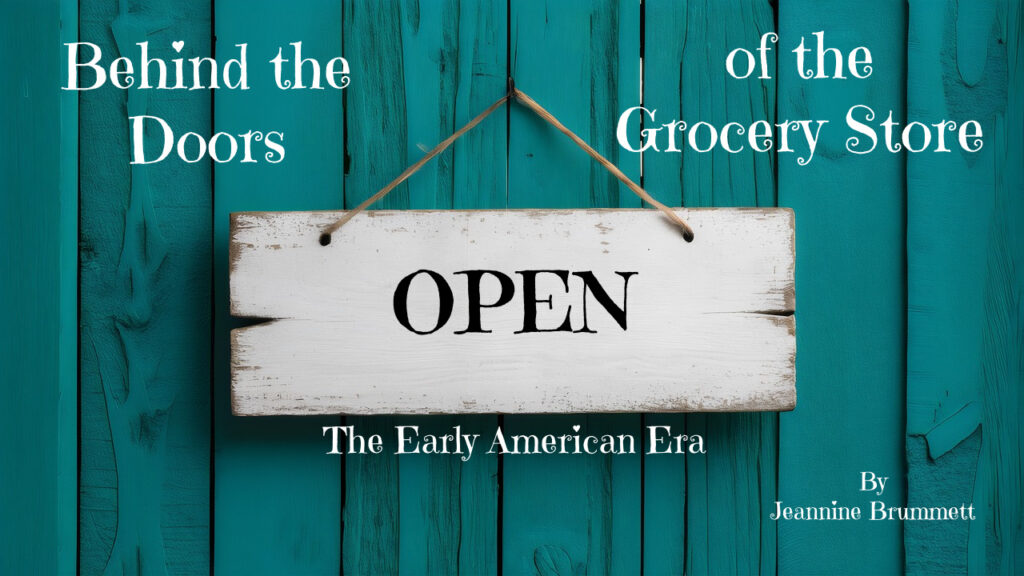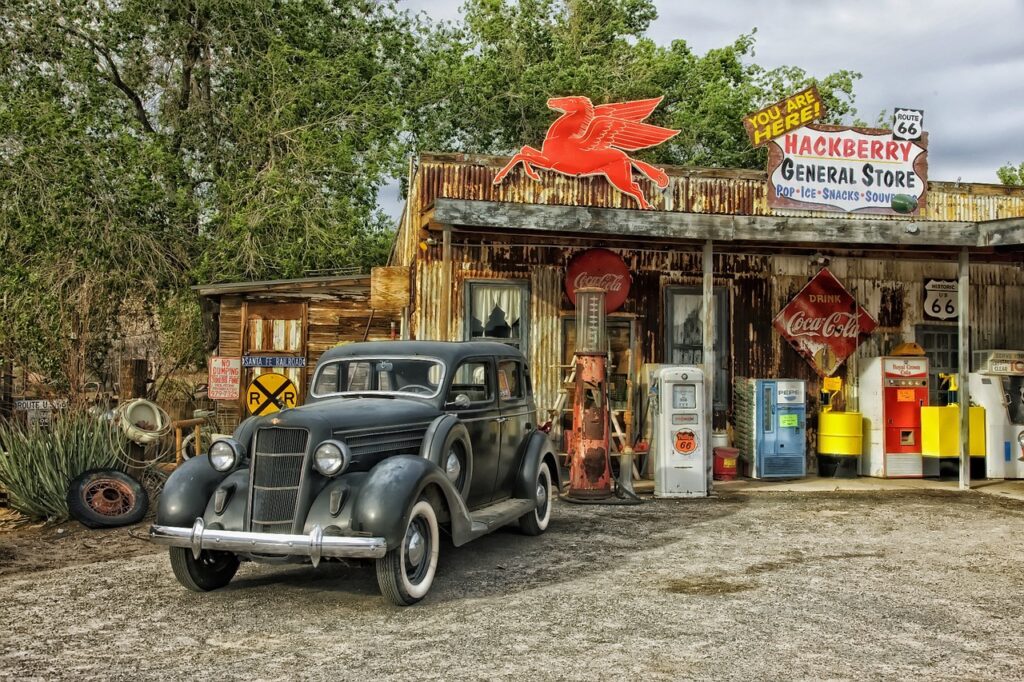
For writers, opportunities wait behind the doors of the grocery store!
A plethora of plots. Character reveals. Centuries of setting choices.
Plots or sub-plots—romance, thievery, espionage, even murder—hope to be chosen for a writer’s next work. Love blooms on Aisle 4. A desperate mother shoplifts. Dollar bills go missing from the money box. Who poisoned the produce?
Character reveals or characters revealed? There’s a place for both in the grocery store. The helpful or bitter proprietor. The responsible cashier. The jerk of a clerk. Or the unexpected, welcome or dreaded, encounter at the meat counter.
Along with plots and characters, a variety of grocery store settings are available for the picking. From as far back as the infant years of the United States, shops afforded goods to consumers: Trading Posts. General Stores. Mom-and-Pop shops. Full-service grocery stores.

Spanning four centuries, 17th through the early 20th, customers could make purchases at the TRADING POST, GENERAL STORE or a MOM-AND-POP shop. Demographics, architecture and technology might change, but the overall model of these establishments remained during this era.
TRADING POSTS arose and scattered across the United States as adventurous folks moved westward to explore the land. Initially, the trappers who operated the posts traded guns, ammunition, cloth and trims, and cookware to the local Indian tribes in exchange for furs and food. Bartering was common as opposed to a fixed-price system. Extending credit was common, luring customers to return.
Over the decades the face of the Trading Post morphed according to the increase in population and the changing landscape as more people moved west to settle in communities. Farmers, ranchers, travelers by stagecoach or rail, Pony Express riders, along with the Indian tribes might do business at the Trading Post. The proprietor would keep busy stocking shelves, bartering and selling, and cultivating working relationships and friendships with customers.

GENERAL STORES
The locale of the store would determine much of the product offered to the customer. For example, if the General Store is the only shop in a tiny town, though they provide mostly dry goods, at times they might have eggs, fresh fruit or vegetables brought in by a local farmer in exchange for credit or product. They may also stock items that are unique to the needs of those area residents. Specialty items were likely ordered and took a long time to receive. The post office might deliver mail to their facility and the customer would pick it up when they came by.
If the General Store is located in a large town or city where numerous specialty businesses operate, dry goods would be their main stock,
A day in the life of the proprietor might include unloading a shipment of goods or stocking shelves. Customers, both men and women, would hand him a list, or simply tell him what they needed. The requested items would be placed on the counter. After calculating the cost, the owner would load them in the customer’s sack or wagon to take home.

By 1883, proprietors might have set aside their pencil and paper and used a cash register which was invented by James and John Ritter circa 1878.
MOM AND POP shops are distinguished from General Stores in that they are usually family-owned and often a specialty store such as butchers, bakers, pharmacists, or shoemakers, etc.
Mom and Pop stores were likely flanked on either side by other stores in a string of buildings on the main street of town. Owners often lived on the second floor.
Progressing into the 20TH CENTURY
In 1916, Piggly Wiggly opened the first self-service establishment. Customers could walk along the aisles and pick out what they wanted to purchase, then take them to check-out for tabulation and bagging. Regional chain stores, as late as the 1920s, continued counter-service for procurement of dry goods.
Shoppers still needed to visit the specialty shops for meat and produce.
Circa 1937, King Kullen opened the first grocery store featuring an onsite baker, butcher and a large produce department.

Shortly after King Kullen’s opening, the shopping cart was introduced. This made shopping easier for the customers, but also, the sale of more merchandise increased profits for the owner.
These early 20th century advancements in grocery services paved the way for the shopping experiences enjoyed by 20th and 21st century consumers. But that’s a story for another day.
As for creative writers, fodder for meaningful and exciting stories waits behind the doors of any Trading Post, General Store, Mom and Pop shop, or Full-service Grocery Store.
One just needs to look to find them.

Jeannine Brummett lives in South Carolina with her husband of nineteen years, Don, who shares his three adult sons and three grandchildren with her. Reading is big on her list of things to do, but she also thrives on TV crime dramas, NBA basketball, and marvels at the critters and fowl life that live at the pond behind their house. She loves to sing praise songs, attend Bible Study, and help at a local food pantry.




No Comments